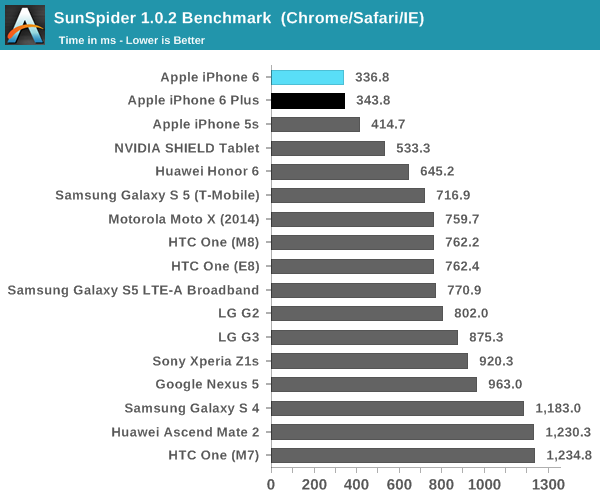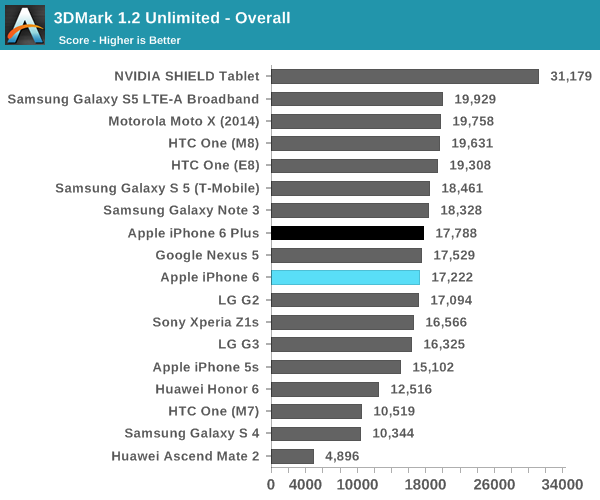The new silicon at the heart of Apple's recently-released iPhone 6 and iPhone 6 Plus has increased the company's lead in smartphone application processor performance, according to data released on Monday, with the A8 improving on the already industry-leading 64-bit A7.
The iPhone 6 saw an impressive 13 percent bump in performance over the iPhone 5s on the SunSpider browser performance benchmark, according to AnandTech. Other CPU-bound benchmarks followed a similar trajectory, with the iPhone 6 or 6 Plus leading the way in all but one category.
In light of the results, the publication reiterated its previous stance that the A8's performance improvements are unlikely to be the result of its 100 megahertz clock speed bump alone. At the time of the A8's announcement, the group wrote that Apple is likely to have "enhanced or otherwise significantly optimized" the A8's processor core, which would represent "a significant accomplishment" given the time frame involved.
Apple's latest handsets posted a more up-and-down showing when it came to GPU performance, finishing near the bottom of the pack in a physics simulation, while besting all but Nvidia's Shield tablet in most other areas. Overall, they showed "a pretty solid lead over the competition for the iPhone 6/A8."
One area of concern was the GPU performance of the iPhone 6 Plus. The 5.5-inch device — Â which renders content at 2208-pixels-by-1242-pixels before downsampling to 1920-pixels-by-1080-pixels — Â was more sluggish, which AnandTech posits is due to the required high-resolution rendering.
Finally, battery life was found to be "quite incredible." The iPhone 6's 11 hours of web browsing battery life was "a step above just about every other Android smartphone on the market," while the iPhone 6 Plus bested all but Huawei's 6.1-inch Ascend Mate 2 by at least two hours.
 Sam Oliver
Sam Oliver









 Wesley Hilliard
Wesley Hilliard
 Malcolm Owen
Malcolm Owen
 Andrew Orr
Andrew Orr
 William Gallagher
William Gallagher
 Sponsored Content
Sponsored Content
 Christine McKee
Christine McKee

 Thomas Sibilly
Thomas Sibilly






64 Comments
wouldn't mind seeing these stacked against x86 CPUs
Wait, why?
As for cellular speed, I see ping times that are about 2.5x slower with the 6 Plus than the year-old iPad Air (AT&T LTE, 3 bars). This is using Speedtest app. 160+ ms for the 6 Plus, ~60 ms for the iPad Air.
Wait, why?
Downsamples to render objects at the proper size for the screen. I would imagine a regular 1080p screen would greatly reduce GPU strain, but Apple may have considered improved sharpness and other LCD characteristics worth the tradeoff. See recent DisplayMate review.
The 3d benchmark does not compute! Whats up here... With Metal , Scene and Sprite kit one would expect stellar performance ! My suspicion is that the benchmark is somehow not compatible with apples new technology .. Any insights from those more in the know !?